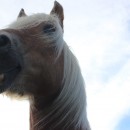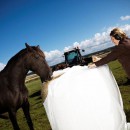Supplement forage with forage
You can actually supplement forage with forage! This can be really useful in stables where you have horses with different energy and...
Read MoreVitamin E and A in forage for horses
Vitamins are essential organic compounds and they exist in small amounts in natural feeds. They are divided into fat soluble vitamins A,...
Read MoreCorrect wrapping gives airtight bales
When wrapping bales it is useful to stretch the plastic film about 70%; draw two parallel lines with a felt pen with 10 cm apart on the...
Read MoreCorrect driving technique gives better bales and higher profitability
To get an even density of the bale the swath has to be even. The bale gets a straight profile and even density if the swath is a little...
Read MoreCut or long-stemmed forage – does it make a difference to the horse?
Wrapped forages for horses are usually conserved long-stemmed, for other animals it is more common to cut or chop the forage before baling...
Read MoreHarvest date most important for protein and fibre in red clover
Red clover (Trifolium pratense L.) is protein rich and relatively risk-free to grow. The later the stage of maturity the lower protein...
Read MoreAdditives for the ensiling process
Additives in silage are to help the ensiling process and they can be chemical in the form of organic acids, for example formic acid, or...
Read MoreAccess to forage in the paddock positive for fertility rate
That horses have both nutritionally and mentally a great need for eating forage is well known and to be without access to forage during...
Read MoreForage buffers the hindgut
The feeding practices can have impact on the ecosystem in the hindgut of the horse. This study examined the effect on the hindgut...
Read MoreHygienic quality of haylage autumn and spring
Making haylage instead of silage can imply a higher risk of mould growth in the bales. Haylage is drier and in wrapped forages with DM...
Read More









